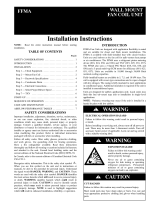
FX4D
Installation Instructions
DIRECT EXPANSION FAN COIL UNITS
FOR PURON® REFRIGERANT
SIZES 019 TO 061
NOTE: Read the entire instruction manual before starting the
installation.
TABLE OF CONTENTS
PAGE
SAFETY CONSIDERATIONS 1........................
INTRODUCTION 1..................................
HEATER PACKAGES 1..............................
INSTALLATION 1...................................
Step 1 -- Check Equipment 2..........................
Step 2 -- Mount Unit 2...............................
Step 3 -- Air Ducts 4................................
Step 4 -- Electrical Connections 4......................
Step 5 -- Refrigerant Tubing Connection and Evacuation 7...
Step 6 -- Refrigerant Flow-- Control Device 7..............
Step 7 -- Condensate Drains 8.........................
Step 8 -- Accessories 9...............................
Step 9 -- Sequence of Operation 9......................
START-- UP PROCEDURES 10.........................
CARE AND MAINTENANCE 10.......................
AIRFLOW PERFORMANCE TABLES 11................
PURONR (R--410A) QUICK REFERENCE GUIDE 12......
SAFETY CONSIDERATIONS
Improper installation, adjustment, alteration, service, maintenance,
or use can cause explosion, fire, electrical shock, or other
conditions which may cause death, personal injury or property
damage. Consult a qualified installer, service agency, or your
distributor or branch for information or assistance. The qualified
installer or agency must use factory--authorized kits or accessories
when modifying this product. Refer to the individual instructions
packaged with kits or accessories when installing.
Follow all safety codes. Wear safety glasses, protective clothing
and work gloves. Have a fire extinguisher available. Read these
instructions thoroughly and follow all warnings or cautions
included in literature and attached to the unit. Consult local
building codes and the current editions of the National Electrical
Code (NEC) NFPA 70.
In Canada, refer to the current editions of the Canadian Electrical
Code CSA C22.1.
Recognize safety information. This is the safety --alert symbol
.
When you see this symbol on the unit and in instruction manuals,
be alert to the potential for personal injury.
Understand the signal words DANGER, WARNING,and
CAUTION. These words are used with the safety--alert symbol.
DANGER identifies the most serious hazards which will result in
severe personal injury or death. WARNING signifies hazards
which could result in personal injury or death. CAUTION is used
to identify unsafe practices which may result in minor personal
injury or product and property damage. NOTE is used to highlight
suggestions which will result in enhanced installation, reliability, or
operation.
ELECTRICAL OPERATION HAZARD
Failure to follow this warning could result in personal injury
or death.
Before installing or servicing unit, always turn of f all power to
unit. There may be more than 1 disconnect switch. Turn off
accessory heater power if applicable. Lock out and tag switch
with a suitable warning label.
!
WARNING
CUT HAZARD
Failure to follow this caution may result in personal injury .
Sheet metal parts may have sharp edges or burrs. Use care and
wear appropriate protective clothing and gloves when
handling parts.
CAUTION
!
INTRODUCTION
Model FX4D is designed for flexibility and can be used for
upflow, horizontal, or downflow (kit required) and manufactured
and mobile home applications. These units are designed to meet
the low air leak requirements currently in effect. Because of this,
the units need special attention in the condensate pan and drain
connection area and when brazing tubing. These units are designed
specifically for Puronr refrigerant and must be used only with
Puronr refrigerant air conditioners and heat pumps as shipped.
These units are available for systems of 18,000 through 60,000
Btuh nominal cooling capacity . Factory--authorized, field--installed
electric heater packages are available in sizes 5 through 30kW. See
Product Data literature for available accessory kits.
HEATER PACKAGES
This unit may or may not be equipped with an electric heater
package. For units not equipped with factory --installed heat, a
factory--approved, field--installed, UL listed heater package is
available from your equipment supplier. See unit rating plate for a
list of factory--approved heaters. Heaters that are not factory
approved could cause damage which would not be covered under
the equipment warranty. If fan coil contains a factory-- installed
heater package, minimum circuit ampacity (MCA) and maximum
fuse/breaker may be different than units with a same size
field--installed accessory heater . The difference is not an error and
is due to calculation diferences per UL guidelines.













